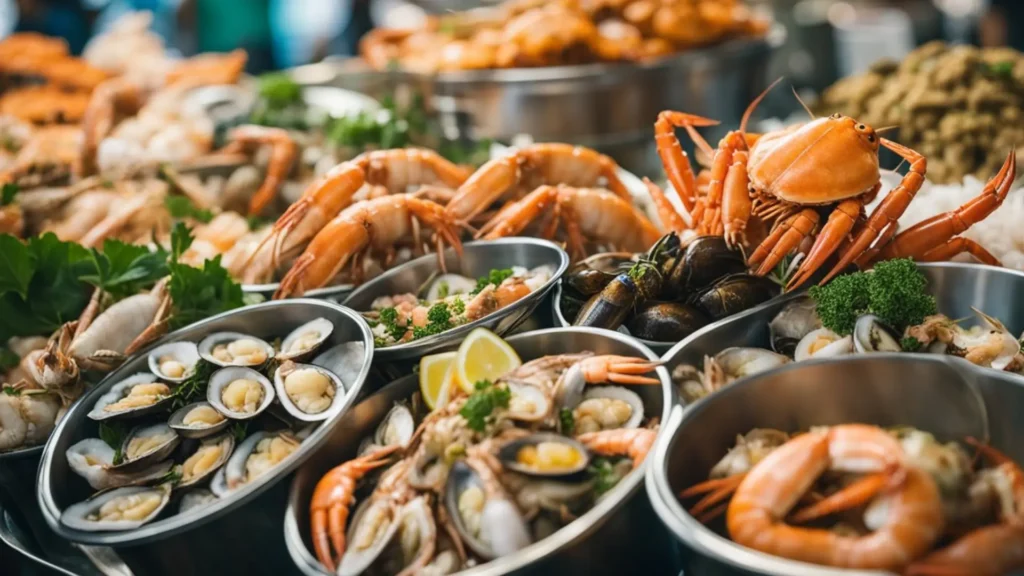As you explore the culinary world of seafood restaurants, you’ll find that the art of preparing fish and shellfish varies significantly across techniques, each enhancing the natural flavors and textures to their peak. Grilling, for instance, imparts a smoky char that’s irresistible on firmer fish like tuna, while the delicate process of poaching in a court-bouillon can highlight the subtle flavors of flounder. Meanwhile, the rapid sizzle of deep frying transforms simple squid into crispy calamari, a crowd favorite. However, understanding the nuances behind these methods isn’t just about taste—it’s about mastering the heat, timing, and ingredients that interact with seafood. You might wonder, what specific factors must you consider to perfect these techniques in your kitchen?
Grilling and Broiling Seafood
Grilling and broiling are quintessential methods for preparing seafood, offering a quick, high-heat process that sears in flavors and preserves the delicate texture of fish and shellfish. When you’re grilling, you’re applying direct heat from below, typically using a gas or charcoal grill. This method is ideal for firmer fish like salmon or tuna, which can withstand the intense heat without falling apart. To ensure even cooking and prevent sticking, it’s vital to preheat the grill and clean the grates thoroughly. A light brushing of oil on the seafood can also enhance flavor infusion and aid in the searing process.
Broiling, on the other hand, involves cooking seafood under direct heat from above. This technique is highly effective for thinner fillets or shellfish. It’s crucial to position the seafood at an optimal distance from the heat source to avoid overcooking. The broiler’s intense top-down heat creates a beautifully caramelized surface while keeping the interior moist.
Both techniques activate the Maillard reaction, where amino acids and reducing sugars react, developing a rich array of flavors and enticing aromas. Mastery over these methods allows you to optimize the sensory profile of seafood restaurant, turning a simple dish into a culinary delight. Remember, precise timing and temperature control are key to preventing overcooking and achieving perfect results.
Steaming and Poaching Methods
Why not explore the gentle art of steaming and poaching, techniques that preserve the delicate flavors and textures of seafood with precision and care?
Steaming involves cooking seafood over, but not in, simmering water. This method utilizes the steam’s heat to gently cook the fish, ensuring that the moisture is retained and the seafood’s intrinsic flavors aren’t overwhelmed. As a chef, you’ll find that steaming allows for a healthful preparation, as it minimizes the need for added fats and oils.
On the other hand, poaching submerges seafood in a liquid at a low temperature, typically around 160-180°F. This technique is ideal for enhancing the seafood with aromatics and spices infused in the poaching liquid, known as a court-bouillon. Poaching is particularly suitable for delicate items like fish fillets, which might disintegrate under intense, direct heat. It’s crucial to maintain a gentle simmer and avoid boiling to ensure the seafood remains tender and doesn’t toughen.
Both methods require precise timing and temperature control to prevent overcooking. Mastering these could elevate your seafood restaurant dishes, offering your patrons a memorable dining experience that highlights natural flavors and textures.
Frying Techniques Explored
Turning our attention to frying, this technique offers a crisp texture and rich flavor that can’t be achieved with steaming or poaching. As a chef, you’ll find that mastering frying methods is essential for elevating your seafood dishes.
Let’s dive into deep frying and pan-frying, the two primary approaches. Deep frying involves submerging seafood in hot oil, typically between 350°F and 375°F. This high temperature cooks the seafood rapidly, sealing in moisture and ensuring a succulent interior beneath a golden crust. It’s crucial to maintain oil temperature; dropping below the ideal range can lead to greasy, soggy results. Commonly used oils with high smoke points include peanut, canola, and sunflower oil.
Pan-frying, on the other hand, requires less oil and offers a bit more control over the cooking process. It’s ideal for fillets or smaller seafood items. The key here is to use a heavy skillet and to get the oil hot enough so that the seafood sizzles upon contact, but not so hot that it burns the exterior before cooking through. It’s a delicate balance, ensuring that each piece is evenly browned and cooked to perfection. Both techniques require vigilant temperature control and timing to achieve the desired culinary effects.
As you explore the culinary landscape of seafood restaurants, you’ll discover that each cooking method—grilling, broiling, steaming, poaching, and frying—plays a pivotal role in enhancing the inherent qualities of seafood.
Embrace the charred flavors of grilled salmon, the delicate texture of poached cod, or the crispy exterior of fried shrimp. Mastering these techniques ensures a gourmet experience, elevating the natural flavors and textures of seafood to create dishes that are both artful and delicious.
Learn more:
Choosing the Perfect Seafood Restaurant for Your Occasion

